If you’ve noticed your little friend the goldfish turning white in recent days, you are probably concerned. Is that normal? Do goldfish change color naturally? Should she do that? Is she ill? Why is my goldfish white!?
They do come in many colors, naturally, and some of them are naturally white. But if your goldie start out that way, these concerns and questions are good to look into.
There are many reasons why this might be happening, but not all of them are bad.
Let’s take a look.
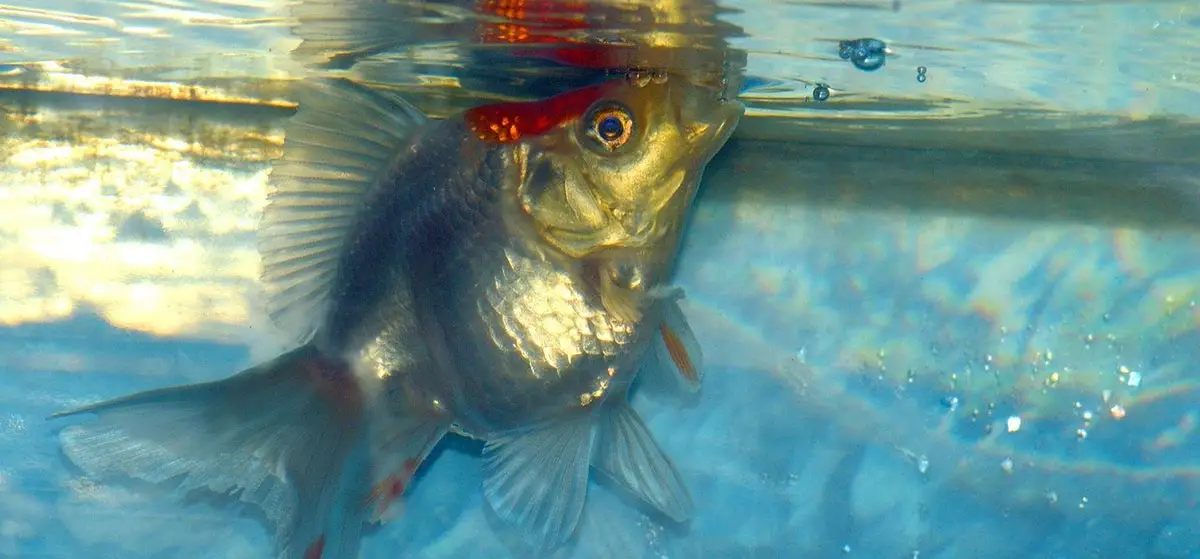
Why Is My Goldfish Turning White?
As I mentioned before, there can be both normal, healthy things and concerning things that can cause your goldfish to lose its coloring.
Here’s a list of the majority of reasons why did my goldfish turn white. Take a look through each, see what coincides with your aquarium or other symptoms of your little goldie, and see what can be done to help your fish.
1. Your Goldie Isn’t Getting Enough Sunlight
One of the most common reasons for your goldfish losing color is simple: she’s not getting any sunlight. It’s a well-known fact with breeders that goldfish that live outdoors in ponds where they get sunlight have brighter, more vibrant colors.
Inside, our fish miss these benefits, especially since we’re actually told not to keep aquariums in direct sunlight for various reasons.
Top Tip: Full spectrum LED lights can help (and are needed for other reasons), but it’s not the same as natural sunlight.
Some goldfish keepers have given their goldfish some “sunbathing rights.” By this, I mean they’ve moved their indoor goldfish into sunny areas short-term to help improve their sun exposure.
You can do this by putting them outdoors on sunny days in goldfish bowls for a few hours at a time. This does not need to be done every day (in fact, should not be) and should not be done during hot days.
The water in the bowls will heat up too quickly and may cause harm to your fish if the temperatures are not monitored. Use a thermometer to keep track.
You also need to keep the water aerated while they are in the sun, to help avoid overheating your fish as well as provide the necessary oxygen.
If your fish has turned completely white, sunlight will not likely restore color.
2. Your Goldfish’s Diet Isn’t Cutting It
Another reason your goldfish could be turning white is a lack of vital nutrients. The right diet greatly affects the color of your fish, not just the health of your goldie.
Make sure that your goldfish is not only getting gel food (flake and pellets are nearly always loaded with fillers that may harm your fish) but supplemental foods as well, like Spirulina and algae wafers.
Goldfish can also be a little like flamingoes. Yeah, you read that right.
Flamingoes change color based on their diet. The more shrimp they eat, the pinker they get – thanks to the amount of beta carotene in the crustaceans.
Goldfish also can change colors based on the amount of nutrients they eat. So, they may turn white because of a lack of certain nutrients as mentioned above.
This means if you use products that are marked for “color enhancement” for your goldfish, you may be able to deepen the color of your goldie.
Again, be sure that the foods you feed them are gels instead of flakes and pellets made with fillers.
Author Note: Koi keepers have also learned that ingestion of Bentonite Clay helps to enhance the coloration of carp.
3. Your Goldfish Has the Genetics to Turn White
Another reality? Your goldfish may simply have the genetics to turn white instead of staying bright orange. It might seem odd, but genetics in goldfish coloration is complex and variable.
Some colors are notoriously unstable, like black, for instance.
You really can’t do much about the genetics of your fish unless you breed them for yourself, selecting those that have displayed certain desirable attributes.
There are several things within genetic building that affects the colors of goldfish.
First, the scale type of your goldfish can affect the color of your little goldie. Some scales are metallic, some matte, and some nacreous.
Metallic scales are what the name implies – shiny, shimmery, metallic looking. These are the scales that seem like tiny gems sparkling in the water.
Matte scales are the flat, non-shimmery looking scales.
Nacreous scales are those that have a sort of pearl-esque appearance.
Any of these scale types can affect the way goldfish appear, though, not likely to change color from gold to white too much, though if the goldfish is pale, it can affect the appearance.
Guanine is another component of the genetic appearance of goldfish. Guanine is a chemical in their DNA.
This chemical exists under their scales and helps refract light. This makes goldfish appear shiny or make the scales look like a single smooth scale instead of individual scales in some cases.
Finally, chromatophores determine the actual color of your goldfish.
Chromatophores – as the term “chrom” implies – are the cells that give coloration to the structures for your goldfish’s scales.
Chromatophores also occur in animals like chameleons. Goldfish, however, do not have the ability to change color to adapt to their environment.
But it can occasionally happen as a limited sort of camouflage.
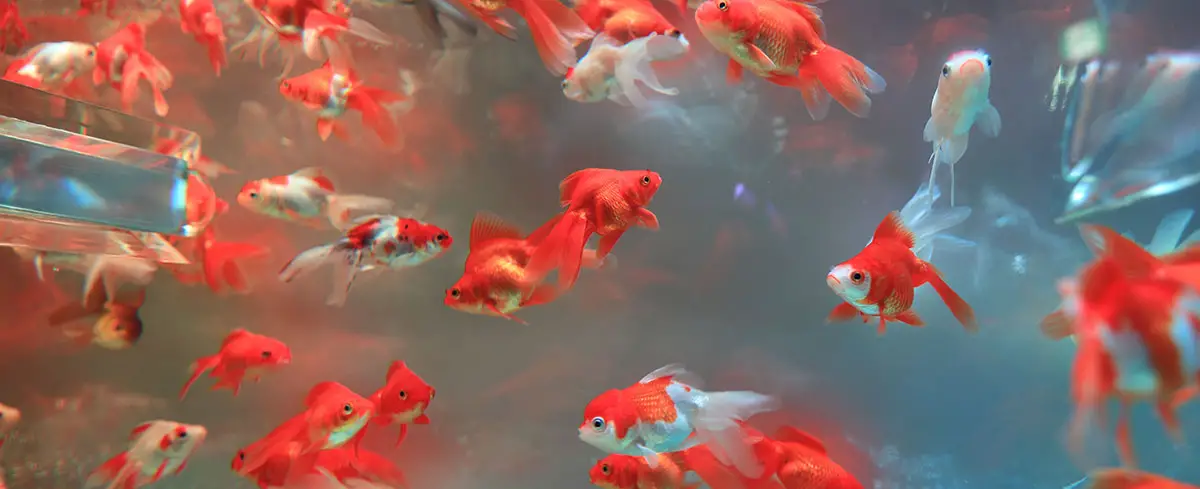
4. Your Goldfish Is Getting Older
Another common issue isn’t an issue at all, it’s just facts. Goldfish tend to lose their color as they grow old. If you look at the world’s oldest goldfish, you’ll notice none of them have orange coloring.
The color change should be gradual, though, if it is age-related.
There should be no other noticeable signs, save perhaps the fish getting a little slower due to old age. This should also come on gradually.
Author Note: The oldest fish are all white. It’s a bit like humans and other mammals who lose their hair pigment and go gray in their later years.
Goldfish can live to be ten years or older when properly cared for so they can definitely age out of their vibrant colors the way humans and other mammals can.
5. Your Goldfish is Ill or Stressed
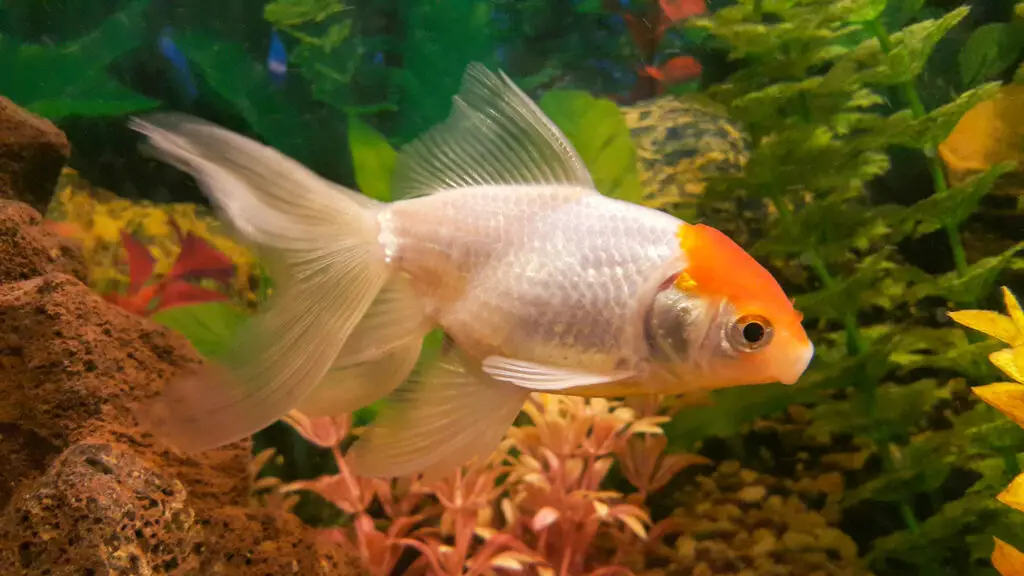
One of the biggest reasons you should be concerned about your goldfish turning white is the potential of illness and/or stress.
Typically, the other issues are what’s going on (age, lack of sunlight, genetics, etc.), but if other things start happening, your goldfish could be in trouble.
Top Tip: If you notice that your goldfish is losing scales or turning white, you’re definitely looking at an ill fish.
Or if you notice that the colors are muted but not turning white, per se, then you’re also likely dealing with a sick fish.
If black is a muted or soft brown, for instance, or yellow looks cream, orange is turning pale orange or pink – your guy is in distress.
It is possible that your goldfish turning white and dying could happen. Immediately check with a vet if you notice any of the symptoms of illness, especially scales falling off or muted colors, distended belly, et cetera.
Other symptoms to look out for include a fish taking a long time to swim up and down the aquarium or lacking in appetite.
If your little goldie normally gobbles up her food but doesn’t have much of an appetite lately, you need to get her checked out.
If your fish is helped in time, he will recover and his coloring should return with good health.
It should be noted that stress can also cause paling of color, especially if the fish was shipped recently or moved from one house to another. The color will return for the stressed fish, as well, once the stress has been reduced.
6. The Aquarium May Have Low Oxygen Levels
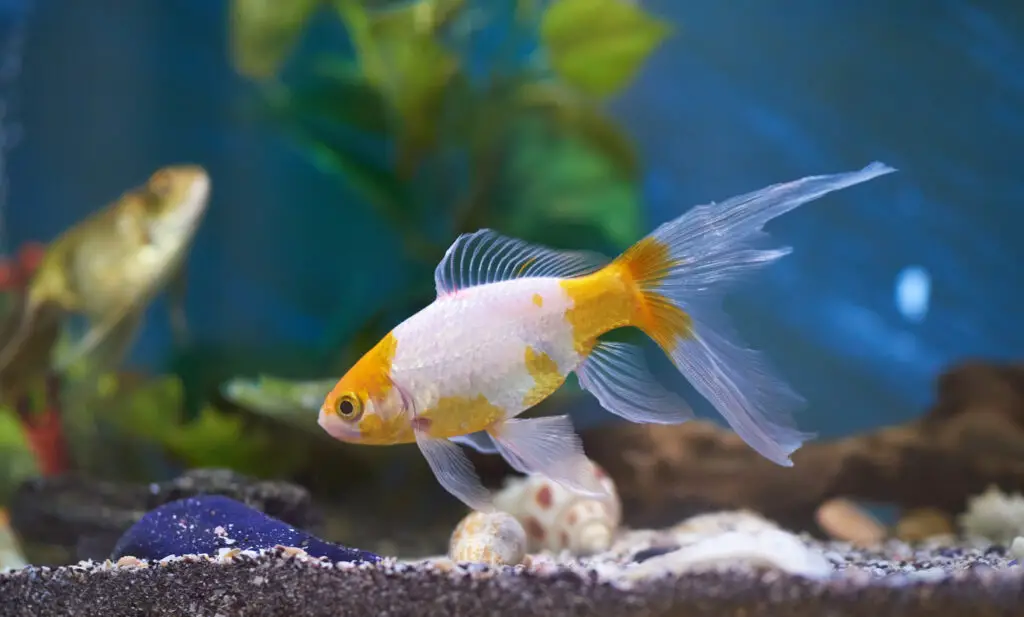
If your goldfish is turning translucent white, this is another cause for concern. This likely means that there is too little oxygen in your fish tank. This could lead to severe illness or even death for your little friend.
To see what’s going on with this, test your water. There are testing kits that will allow you to see oxygen levels. Check the numbers against what they should be for your type of aquarium and size.
The water for a healthy goldfish should contain 5-6 ppm. More or less ppm will stress your goldfish and may lead to the color changes or even illness.
Author Note: If your oxygen levels are too low, you need to start with a large water change of at least 60% ASAP. Acting immediately could save your goldfish’s life and give him a chance to recover.
You should also then add in an air stone, powerhead, or another form of aeration to keep the oxygen levels high enough that this doesn’t become a concern again.
Learn More: Why is my goldfish turning black?
Top Tip: Check your goldfish’s water chemistry weekly to help ensure there’s enough oxygen and not too much of any of the potentially harmful chemicals that harm your fish.
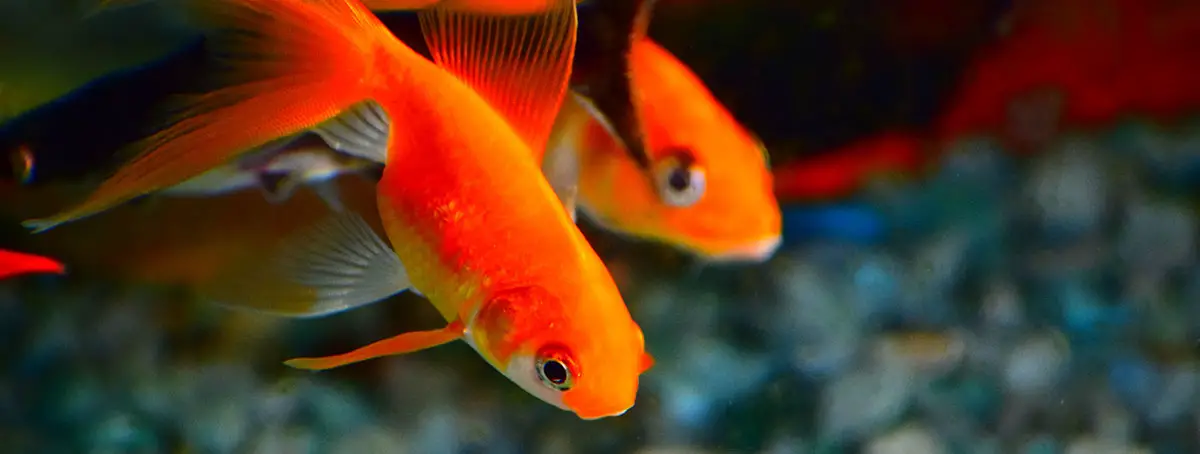
Should I Be Concerned That About my Goldfish Turning White?
If you see your goldie turning white, you’re probably instantly alarmed. But there’s good news. A goldfish turning white isn’t always a scary thing.
In fact, sometimes when a goldfish turns white, it’s just “giving in” to its genetic pull.
After all, not all goldfish are naturally orange. It’s sort of like a kid born with blond hair turning brunette later in life. It’s the same kind of concept.
Of course, sometimes there can be concern about what’s happening.
It’s best not to make assumptions – but to look into the potential causes and see whether or not your little scaley pal is just growing up or dealing with something problematic.
Natural Goldfish Colors
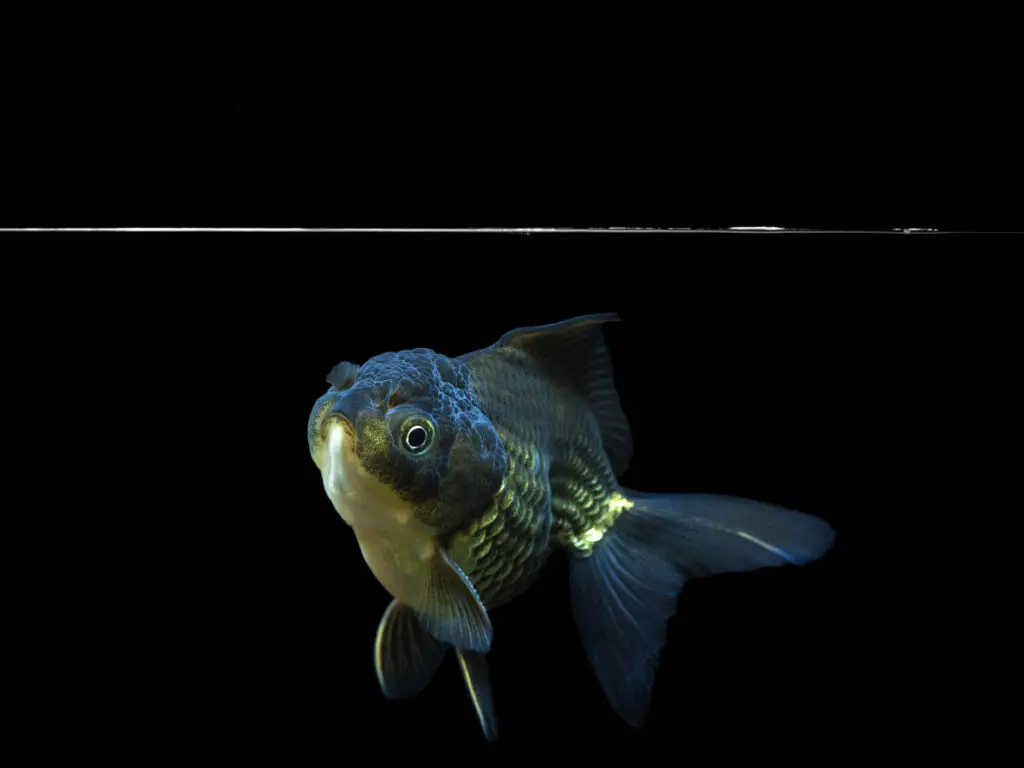
Before we take a look at the causes for goldfish turning white, let’s quickly look at natural colors for goldfish.
Goldfish are a part of the carp family (Cyprinidae). They’re natively swimming around in environments where they don’t want to stand out – and are actually a bit dull in color.
Once goldfish became a part of the fishkeeping industry way, way back in ancient China, they started to gain more and more color as they were bred to be ornamental and inviting.
The mutations created brought about deeper reds, brighter oranges, etc. in these little fish.
Goldfish come in a wide range of colors now, including
- White
- Orange
- Red
- Bronze
- Calico
- Blends
- Yellow
- Black
- Blue-ish gray
- Brown
In some cases, goldfish start off one color and change as they age.
Can Your Goldfish Ever Get Back Its Color?
Now that we’ve answered why is my goldfish turning white, let’s look to see if your goldfish will ever get its color back.
The reality is this isn’t a straight answer. Some goldfish will regain their color. Some will not.
When your goldfish will regain color:
- Corrected diet
- Getting enough sunlight
- Recovery from illness – most situations, they will recover their color
- Improved oxygen levels – may or may not recover the color
When your goldfish won’t regain its color:
- Aging
- Genetics
- Low oxygen levels – generally they will, but depending on situations, they might not
- Some illnesses – some illnesses affect their permanent looks
What Can I Do to Help My Goldfish?
Obviously, the cause of your goldfish turning white is going to answer specific treatment options for your goldie.
Illness and stress can be treated with certain medications, environmental changes, and antifungal measures.
If your fish is ill, be sure to use medications that are both intended for goldfish and that they are intended for the given condition your goldfish is experiencing.
For fish who don’t appear to be ill, you may need to reduce stress for them. This can be done by adding UV light and improving their diet with color-enhancing foods that provide missing nutrients.
If genetics or age is the culprit for your goldfish turning white, there’s really nothing you can do. These are just part of the natural order of things.
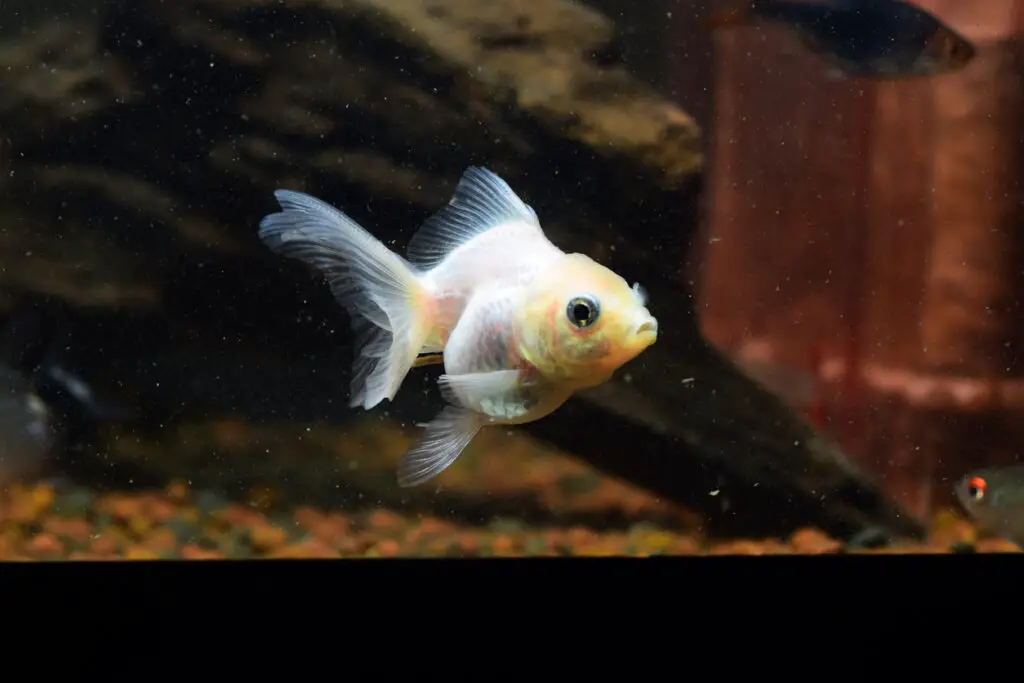
The tree over my pond has gotten so big that very little sunlight is now getting to the pond. I can’t cut down the tree. What other alternatives do I have? Can I use white light from a seasonal affective disorder lamp?
I became so ill for two days I couldn’t even move I begged my family members to clean the fish tank and no one did today I rushed to the tank and my fish were floating with a very bad water condition and a filter that got turned of I changed the water and put the fish in a temporary tank and they all started swimming great except for on his scales started turning white and he took a long time to revive now he is in a better condition and I will be receiving ammonia killer bacteria soon but my question is can he get his color back?
Thank you very much for the info. My oldest goldfish was won at our local fair by granddaughter at age 4 and she is now 14.